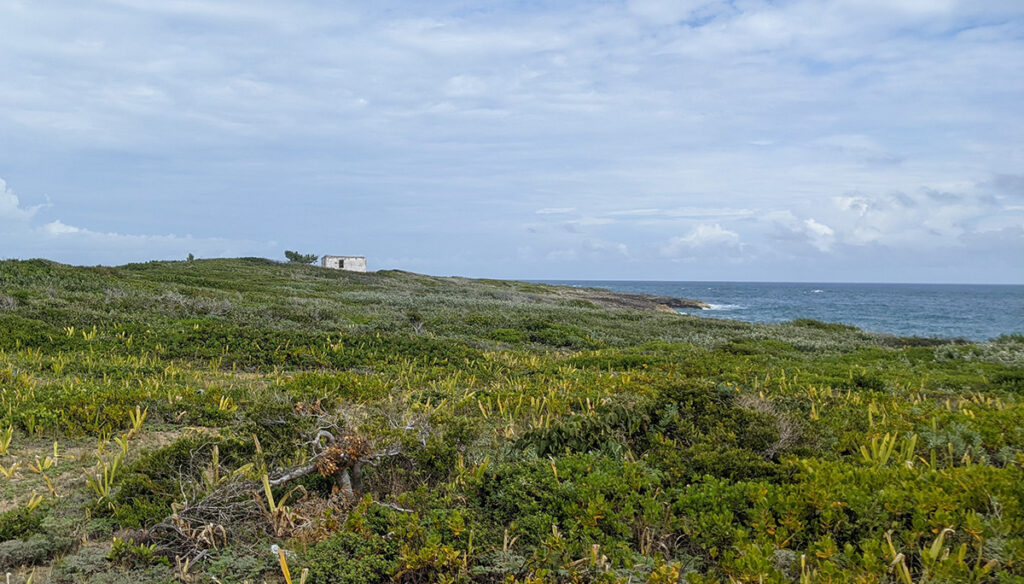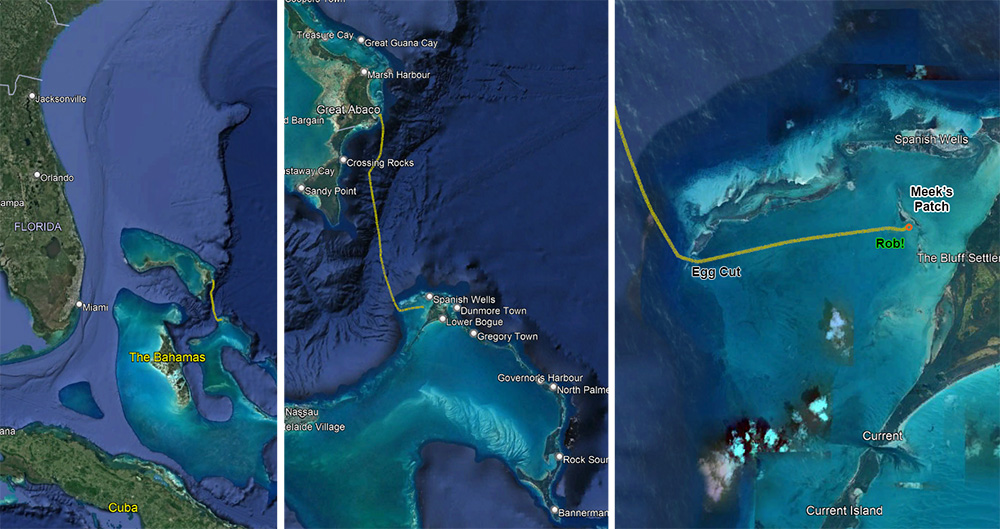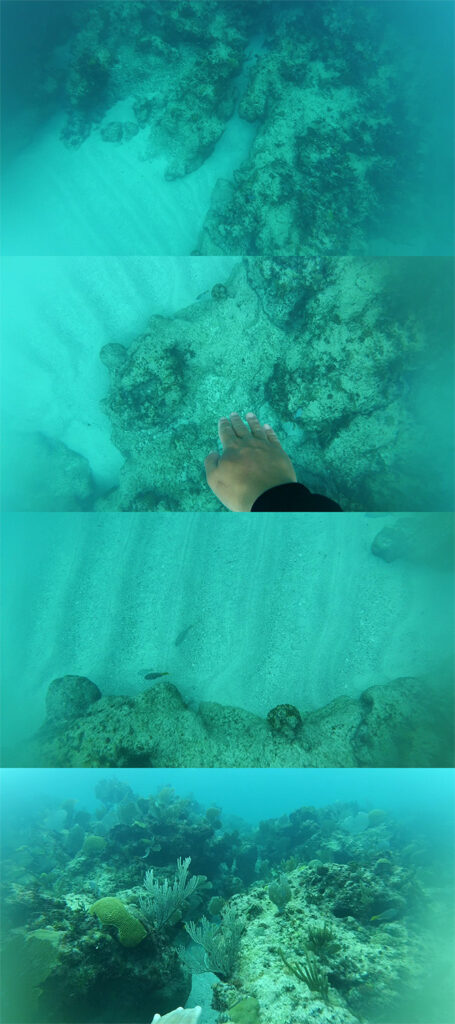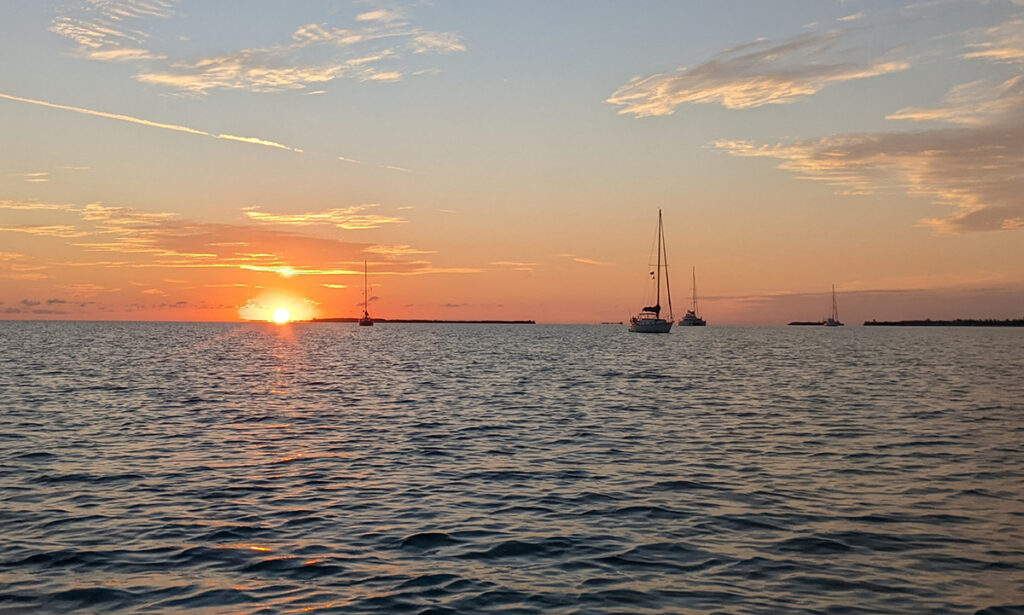
The day after I went solo spearfishing, I spent some time walking around this very small community of artists. Right next to Pete’s Pub, which is an awesome looking but expensive beachside bar and restaurant, is a foundry where the metal sculptures were made. I viewed some of the work at the gallery. I found them to be quite moving. They were beautiful and conveyed some layer of expression I could not immediately grasp. Unfortunately, the foundry itself was closed, due to COVID-19 concerns, so I went for a walk around the foundry. I took another coconut on my walk, but I feared it was also not ripe enough. The path was surrounded by mangrove plants. Every once in a while, you got to peek over them to catch a teasing glimpse of the waves and coral head cliffs. Eventually it all opens up to the sounds, onshore winds, and a blue sky interrupted by a different color of the low-lying vegetation. This line itself is interrupted by an old remnant of a lighthouse. Back at the harbour, you could see two prominent caves right in the harbour, daring the brave to enter. I did not enter, as I am do not posses the right kind of bravery.
Pete’s pub was quiet. I didn’t have high expectations on their ‘Sushi night’ that they host every Friday. I was pleasantly surprised by the tuna dish I tried. It wasn’t really sushi, but it was very good. I struck up a conversation and made a new friend. Nate was an engineer that worked as a skipper for a membership club that hosted guests on really nice boats. He was really experienced in both motor and sailing vessels. We drank a lot of beer together in the outdoor pub, standing on the sand with our faces lit by the patio lights. Little did I know, he’d be mentor of sorts in the future as I try to get more involved in the recreational boating industry.
In terms of buildings, structures and establishments, there wasn’t much. However, what beats waking up at a quiet anchorage, surrounded by cliffs with a beautiful reef outside? But I was out of things to do, and wanted to move on to Eleuthera as soon as I could. I had one more thing to do. Go diving with new friends, Steve and Janice from Steadfast.

Steadfast’s tender had an actual useful, competent powerplant. A fifteen horsepower outboard. Sonora’s tender had a puny two horsepower outboard. It was also a larger dinghy, that could hold three of us and all of our freediving and spearfishing equipment with ease. And we didn’t have to motor half an hour – a mere fifteen minutes at most. We first started by exploring the western side, inside the Sea of Abaco, because Steve had a friend who had put down a lobster casita there.
We look for casitas because they are placed there to attract lobsters. Especially in sandy areas without a lot of topography. Lobster will walk along the sea bed in the darkness looking for food. When the sun comes up, they will seek shelter. If they run across casita, they will hide under it. Is this as morally appalling as raiding someone’s crab trap in the Chesapeake bay? I don’t think so.
Firstly, crab traps are protected under US law. Its considered the trapper’s property, and usually they have to mark it and follow regulations, which requires a permit. In the Bahamas, the government has stated that these lobster ‘condos’ are fair game for everyone. I am not sure how the locals feel about it, but visitors and locals alike regularly check these pallets for lobster, whether they put them down or not. Furthermore, Steve is a friend of the guy who put this one down.

Steve had this neat bucket with a window at the bottom, that allowed us to see clearly what was below the boat. It was limited in how much of the sea bed we could see, but it was still useful. It sure beat having to jump in or stick my head in the water. When we spotted the pallet, me and Steve dove for it while Janice tended the boat.
This casita was a wooden pallet, the same kind that gets used for forklifts.
There was a cinder block on top of it, tethered by some line, to weigh it down and keep it in place. I went down and picked up the pallet and we both looked under it. For some reason, I didn’t see any. Steve saw six of them. We propped the pallet on top of cinder block. It kept falling off. Next, we pulled up the pallet using the boat anchor. I took a few shots at the lobster underneath, and missed. But it caused the critters to walk out, and Steve hit them with his spear.
I had lost my three pronged spear tip at the fridge under my boat in Man-O-War Cay. I was down to my single pronged, flapper barb that is mainly used for shooting fish. It was hard to hit them with my spear. The target area was small, and if I didn’t hit dead center, it would glance off the hard shell. I only managed to get one and Steve got the rest of them. I was really excited. I’d been looking to harvest some lobster for my entire time in the Bahamas and hadn’t been able to get any.
We got to the outer reefs pretty quickly in Steve’s wonderfully fast dinghy. None of us were able to spear any fish, but it was an incredible sight. As I mentioned in previous journals, each reef is unique in its structure, as much as a single cat’s personality differs from another. The ones I visited Friday, where I was basically a killing machine taking legal but small game, was shallow. These outer ones were deep. “You gotta get to the reefs that other people aren’t getting to,” Steve said. “That is where all the big fish are.” This time, instead of hitting all the fish I wanted to eat, we hunted for bigger game.

These reefs were huge structures in deeper water. I did a total of two dives where I got to touch the bottom, but it was a really long way back up. Over twenty seconds to ascend with minimal kicking… it actually took some discipline to not kick, because all your instincts are telling you to get on the surface as soon as possible. It is actually a very good feeling forcing yourself to relax and meditate. Let buoyancy do most of the work. Gliding up slowly to the dancing white light above, a part of you not wanting the leave the wonderful undersea world. Its an ascension to another realm, except its a bit disappointing when you breach. Just back to reality, that’s all.
Huge spires and jagged structures grew out of the sand. It generated a feeling not too different from what you get when you visit the Grand Canyon. The impressiveness of these reefs make it look like it was drawn by a illustrator for an awesome, immersive fantasy video game. It sloped downward, following the contour of the sand, sloping deeper as it reached out to the abyss of the Atlantic ocean. Dark structures built on top of a pristine, white sand. Schools of colorful reef fish looked at us, with their curiosities ranging from fearful to having a desire to school with you. I spotted a few fish I’d have liked to take. A big snapper, a fish I now know as a hogfish, and a big Nassau grouper. The last one peeked out from the deeper end of the reef, probably over fifty feet deep. They aren’t in season, so I left it alone, but I was also too scared to dive that deep anyways. How would I bring such a powerful animal back to the surface, when I’d be at a depth that I’ve never dived before?
I found this combination of fear, curiosity and admiration quite addicting. Perhaps this is why I place fish hunting at the top of the list of activities I’ve been enjoying in the Bahamas.

The plan was to leave the next day. That evening, I went ashore to Pete’s pub to say goodbye to all the new friends I made, though some I’d see again. The next day, Nate went by Sonora on his work boat to say goodbye. I feel extremely fortunate to have met all these people. I hope I run into everyone again.
One of these folks I really wanted to see again was none other than Rob. I had met Rob back in Green Turtle Cay, when Alec was still aboard Sonora. Much like small children do, I found myself wanting to spend some time with people closer to my age. We hung out a lot over there, and had planned to meet again. But I thought maybe he was just being polite. Maybe he was happy to see me leave, so that he could go back to his own version of cruising.
There is a feature called Digital Selective Calling on modern VHF units. Back in Elbow Cay, my radio had sounded a DSC alarm a few times. I suspected that it was him who hailed me. After all, who else had my MMSI number? I couldn’t figure out how to answer it properly. I had hailed him a few times every day before I was in Hope Town as well. Eventually, Rob, the hard-core I-don’t-need-the-internet sailor found Wi-fi service and called me the night before I left Little Harbour. Apparently he was in the Spanish Wells area. He had planned to leave soon, but if I was coming, he could stay a few more days. So that gave me a reason to try to make good time for Eleuthera, the island where Spanish Wells is located.
My bad habits made for some good discussion about good passage making practices. I had originally wanted to leave around three in the morning, which would have given me two hours worth of higher tide before low tide– remember, I had gotten grounded coming in. But alas, I’ve fallen back into my night owl habits, and I wasn’t going to get enough sleep. Doing a long passage without enough sleep feels horrible, and when you arrive, you are trying to catch up on rest. Even if gets you there earlier, it eats up too much of your precious time in the Bahamas. On the other hand, leaving at the next high tide roughly six hours later would make me arrive at Eleuthera at night.

That being said, the last portion of the passage looked pretty safe. After you turn east, passing the cape of Egg Island through Egg cut, its just an incredible plateau of ten foot deep sand. This undersea plateau takes up a huge area that engulfs all of the Eleuthera islands. It is dotted with some low lying rocks that are relatively accurately charted. As long as I gave them a wide berth, I should be okay. To me, this made the early and later morning departure times about equally desirable. I decided to opt for the one that let me get more sleep. Laziness wins again, as usual. Such is the decision making cycle of a cruising sailor.

Although I’ve done long passages over seventy two hours on this trip, I was spoiled the pleasant, short island hops of this January. For some reason, even though I’ve done thousands of miles of sailing at this point, the thought of a twelve hour long passage injected some dread into my brain. I’d been too accustomed to being comfortable. With this anxiety looming over me, I slept.
At seven in the morning, I woke up and did my final preparations. I left Little Harbour without much incident at eight. Between little things I had to do to get Sonora ready for sail, I would stare at the quickly shrinking land mass of Little Harbour. I couldn’t help feeling a bit sad. I am an action junkie and I would squarely categorize Little Harbour, with its single pub and mostly mangrove filled scenery, as boring. But Little Harbour just had this inexplicable charm. This was the last of the Abacos for me, the chain of islands that gave me the bulk of the Bahamas experience so far, and her incredible reefs gave me my first taste of spearfishing. If I could be forgiven for another video game reference, ‘Rest here, weary traveller for great adventure lie ahead,’ is the best way I could describe Little Harbour.
I leaned against my cabin bulkhead lazily and I looked astern. I saw the beautiful cliffs, the beaches, and the poetic lone concrete structure that used to serve a lighthouse standing on a bed of grass all by itself. It slowly shrink into an indistinguishable sliver on the horizon then finally faded away. Goodbye, Abacos. Maybe I will see you again one day. Thanks for being so beautiful.
I ran my motor for a few hours to charge up the batteries, and sent out my location update on the sat-com. After two hours, I got the sails up and shut down the motor. Wonderful. It gets me every time, sailing. My anxiety faded, and I started looking forward to Eleuthera. I was back in my temporarily-forgotten element.
According to the more experienced cruisers I’ve met, this is when the ‘real Bahamas’ began. Settlements less spoiled by tourism. Locals more genuine and friendly. And I didn’t know it at the time, but people were happier from being spared from the effects of Hurricane Dorian. A bit less diving, but even clearer waters and beautiful sceneries.
The seas built up as I headed farther away from land. This wasn’t the Sea of Abacos. There was about fifty-five nautical miles of two thousand fathom, pure Atlantic Ocean before the Eleuthera’s embrace from the North and East. Eventually, huge rolling seas were nudging my boat along. Seven to eight second periods, with a height of about five feet. Its quite a sight. Momentarily, the horizon astern disappears and all you see is a mass of water. This time, not threatening and quite gentle, like riding a big gentle mythical sea-horse. Then you feel a nudge as your stern lifts a bit and the same spectacle repeats at the bow of the boat as the wave passes you. From the view of a passing-by boat, Sonora would appear as if she was sinking. Her hull disappears in the interim elevated horizon, just leaving the mast above the water.
I got time to kill, so I tossed a lure and started trolling from my rod. Almost immediately, all of my line got zapped off my reel. It happened so fast that I couldn’t even grab the rod. A part of me felt bad about my contribution to occean pollution, but most of me wondered about the absolute leviathan this fish must have been. I re-rigged new line onto the rod but I put the rod away and decided to resume reading Songs of a Distant Earth by Arthur C Clarke. Clarke is one of the prototypical hard science fiction authors. He was my favorite sci-fi writer. In between the pages, I’d peek up, check the horizon and look at my instruments. I’d also glance at my rigging, standing and running, to make sure everything was working as it should. Then I’d dip back into the fantastic sci-fi universe contained in the words in my hands.

I was only able to sail for two hours before I had to turn on the engine again. I kept the headsail out, and the now-waning wind still helped to pushed the boat to a brisk six knots. Eventually the wind vane at the top of my mast would point in all directions, as apparent wind dropped to near zero. When winds die, sometimes the wind direction gets less defined and the vane just points in whatever direction the mast is moving. I did my best to tack the headsail to track the confused wind to save time and fuel.
A fine mist of rain started dusting me and my boat. A rain cloud had caught up to me. With this cloud, came a bit more wind. But from a different direction. Ah, so this is a small tropical squall. It was strange getting this temporary speed boost from a different direction. Speaking of clouds, there was a strange, familiar way that the clouds in the subtropics hang about on the horizon. They were different from what I see back home. Was it just deja vu? Or are those the same clouds I saw as a child in Thailand? It took me a while to realize that my mind was recalling what I had seen from old paintings, movies, and other imagery of the Caribbean.
I finished three quarters of the the novel. I actually found it deeply moving. Usually his books evoke awe and provoke thought. This was a lot more bittersweet. The whole novel felt like a deep, heartfelt goodbye to someone that you knew you’d miss and think about for a good portion of your life. And the thoughts it provoked was loss, instead of philosophy. I wondered what was going on in his life when he wrote this book, published on my birth year in 1985.
Although I made this passage faster than I had expected, the sun went down just as I made it through the Egg Island cut. Cut is the word Bahamians use to describe inlets and channels between islands. I think it is because they look like someone had cut a cliff-lined island with a giant hatchet. You have to avoid these when an outgoing tide or other current conflicts with the wind direction. Even if you’re an unlearned sailor and did not plan accordingly, you can visually see the conditions by looking for breaking waves. If you don’t see them, you can still hear them. If audio cues were your first notice not to transit this cut, that would certainly be an embarrassing display of bad cruising ability. This time, with gentle winds from the north and the cut leading east, it was not an issue. Passing between coral head islets was always a cool sight in the Bahamas.
It was only an hour to get to the anchorage Rob was at. He was anchored at the west side of a small group of islands called Meek’s Patch, located about a mile and a half south of Spanish Wells. I tried the VHF again, and this time, I got a faint response from Rob. It was like he was trying to speak to me from a different dimension, through a rift in time that doesn’t make any sense, à la Futurama. I couldn’t really hear him, so I tried again in thirty minutes. We spoke briefly about where to anchor and where he was. He also signalled me by flicking his deck lights on and off. Rob was standing on his boat watching me come in. He looked so familiar, as if he was a really old friend and not one of merely five days.
I anchored uneventfully about fifty meters away from Lena Rae. I was happy to see Rob, but I was tired. I was thinking that we would meet up the next morning, but I could hear the feint sounds of an outboard engine in the darkness. He was already at Sonora when I was still setting the anchor. When he got aboard, we exploded in conversation. Turns out he had been hailing me every day, and sent multiple messages to the number he had for my Whatsapp. My US number doesn’t work in the Bahamas, so I never got them. He said he wasn’t sure if I even wanted to hang out with him again, just like I was. But it was really good to have him back as a travel and dive buddy. Old friends we were, we spent hours on my boat drinking some Bahamian rum on my boat. Floating in the darkness seemingly in the middle of nowhere, Sonora felt very warm, like we had lit a small camp fire.

Rest here weary traveler – This is a reference to a stab-em-up style role playing game called Dark Souls. In this game, you battle various demonic enemies and explore in-game world. At various points, there are camp fires that you can light to save the game. The game is terrifying. Those save points stand out as cozy places in an otherwise scary world. I never played it, but I watched my roommates play countless hours of this game.